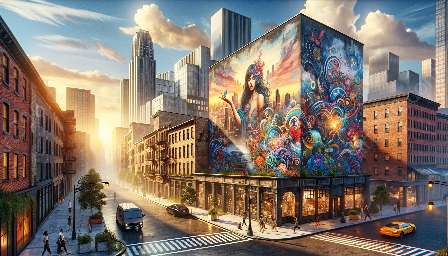Street art has undergone a fascinating evolution over the years, with a significant portion of its development attributed to the influence of pop culture. This dynamic relationship between pop culture and street art has resulted in a vibrant, ever-changing art form that resonates with a global audience. In this article, we will explore the ways in which pop culture has influenced the development of street art, and the profound impact it has had on shaping this expressive medium.
Origins of Street Art
To understand the influence of pop culture on street art, it's important to trace the origins of both phenomena. Street art, often associated with graffiti and murals, has its roots in urban environments where artists used public spaces to express their creativity and commentary. Pop culture, on the other hand, encompasses the cultural elements and trends that are popular at a given time, including music, fashion, film, and more.
Intersection of Street Art and Pop Culture
The intersection of street art and pop culture is where the magic happens. From the early days of graffiti and tagging, street artists have drawn inspiration from the popular imagery and narratives of their time. Whether it's incorporating references to iconic figures, movies, or social movements, street art has constantly tapped into the zeitgeist of pop culture to create engaging and thought-provoking works.
One prominent example of this intersection is the emergence of stencil art, popularized by artists like Banksy. Stencil art, with its ability to capture intricacies and details, has been used to portray iconic pop culture references, thereby blurring the lines between high and popular art. This fusion has not only expanded the appeal of street art but has also challenged conventional notions of what constitutes artistic expression.
Global Impact and Accessibility
Thanks to the influence of pop culture, street art has transcended geographical boundaries and cultural barriers to become a universal language of artistic expression. The adoption of popular culture motifs has enabled street art to resonate with diverse audiences around the world, fostering a sense of cultural exchange and connectedness.
Moreover, pop culture's influence has made street art more accessible to the public. By incorporating familiar references and themes, street artists have been able to engage viewers in a dialogue that transcends traditional art appreciation. This accessibility has not only democratized art but has also empowered communities to reclaim public spaces and redefine their urban landscapes through creative interventions.
Evolution and Innovation
Pop culture's influence has fueled the evolution and innovation of street art, driving artists to explore new techniques, materials, and concepts. The blending of pop culture with street art has given rise to diverse forms such as guerrilla advertising, cultural commentary, and immersive installations, expanding the artistic possibilities within the urban realm.
Furthermore, the symbiotic relationship between pop culture and street art has inspired collaborations between artists and brands, leading to the creation of compelling urban art projects and initiatives. These collaborations often serve as a platform for artists to engage with contemporary cultural trends and amplify their messages through the lens of pop culture.
Influence on Contemporary Art
The impact of pop culture on street art has reverberated beyond the streets, influencing contemporary art practices and movements. By infusing popular culture references into their works, street artists have challenged the elitism of the art world and sparked conversations about the democratization of art, cultural representation, and societal values.
Conclusion
The symbiotic relationship between pop culture and street art has been instrumental in shaping the identity and trajectory of this dynamic art form. As pop culture continues to evolve, so too will street art, reflecting and responding to the cultural currents of our time. Through its enduring influence, pop culture has not only propelled street art into the mainstream but has also elevated it as a powerful medium for social commentary, cultural exchange, and creative expression.

